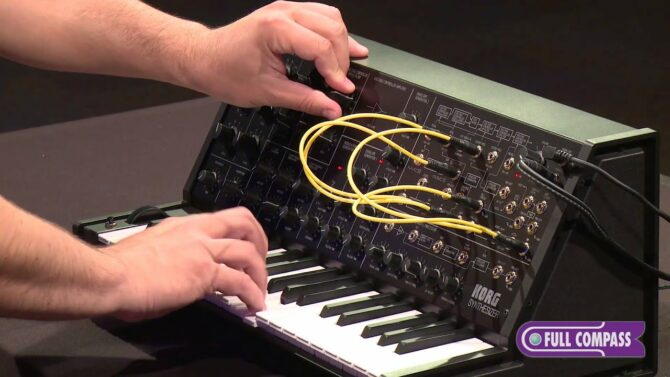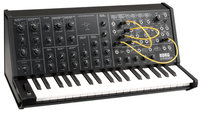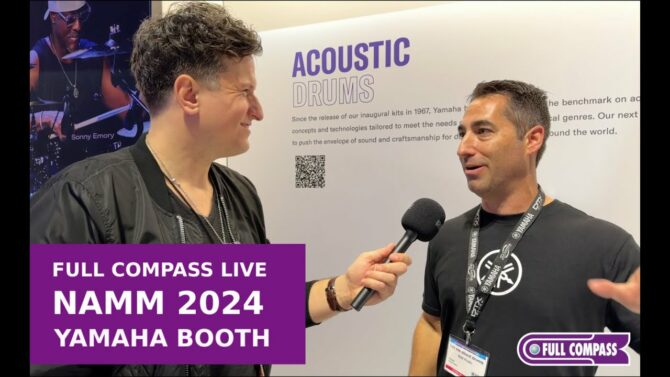Overview of the KORG MS-20 Mini
In the late 70’s Korg created the original MS-20 and became a hit with all kinds of musicians. The new MS-20 Mini is 86% of the original size and has all analog Definition:
Definition:
A signal that is continuous in nature, as opposed to being defined as a series of discrete numbers (or elements) as found in digital signals; electrically "analogous" to an acoustical signal in the air. circuitry, just like the original. It also has the addition of USB Definition:
Definition:
(Universal Serial Bus) A standard, bi-directional serial connection between computers and peripheral devices. and MIDI Definition:
Definition:
(Musical Instrument Digital Interface) A hardware/software standard for communication of musical data digitally among electronic instruments, effects, and computers. However it is also used for to control lighting, pyrotechnics, theatrical displays, and mechanical devices. For example, the fountains at the Bellagio in Las Vegas is controlled by MIDI. Also called MIDI 1.0. ports on the back to easily integrate it into a studio environment.
The great thing about the MS-20 Mini is how configurable it is. On the left side of the panel you can adjust the sound parameters and on the right side you can completely reconfigure the signal path using the patch panel.
The MS-20 is a two oscillator Definition:
Definition:
A device that generates a repeating wave or burst, used in test equipment and sound synthesis. synthesizer. The first oscillator has triangle, saw tooth, square wave Definition:
Definition:
A signal with instant rise and fall times and a flat top, used in testing electronic equipment and for music synthesis., and noise generation Definition:
Definition:
The number of times a recording has been copied.. The second oscillator has an additional saw tooth and square wave, pulse wave, and ring modulation Definition:
Definition:
A signal processing technique where two signals are mixed together, with one modulating the other. This creates sidebands of the sum and difference frequencies, but neither of the original signals appears at the output.. The MS-20 offer a lot of sonic flexibility. When you combine the two oscillators, it has a very powerful, thick sound. It has a great sonic signature that is easily recognizable as the Korg MS-20. If you crank up the peak Definition:
Definition:
A signal's maximum level at any point in time., the sound gets really aggressive.
You can modulate the filter Definition:
Definition:
1. (audio) A circuit that reduces certain frequencies, e.g., a low-pass or high-pass filter for audio. Cf. Equalizer. 2. (optics) reduces certain color wavelengths or polarizations. cutoff in a couple of different ways; from an external control or from the modulation Definition:
Definition:
The process of one signal influencing a different signal, in real time. This can occur with radio frequencies (e.g., using audio to modulate a radio frequency carrier signal), audio frequencies (see FM Synthesis and Ring Modulation), or sub-audio signals (see LFO). wheel. Using the patch cable you can configure Definition:
Definition:
1. To alter the way in which software interacts with a computer system in order to make the software compatible with a specific set of peripherals. 2. To alter parameters in a system's hardware elements so that they can work together in a system context. the modulation frequency Definition:
Definition:
A value, expressed in Hertz, that indicates how many cycles of a periodic signal occur in one second. to route through the high pass and low pass filters.
Below the modulation wheel is an assignable button. The button can be used for a number of different functions. For example, using the patch cables you can assign the button to go through the envelope generator Definition:
Definition:
A synthesizer circuit or software routine that generates a control voltage (or set of digital data) of a predictable nature, most commonly used for controlling the level over time for an amplifier, cutoff frequency for a filter, or pitch for an oscillator. then modulate the pitch Definition:
Definition:
For a given range of audio frequencies, pitch represents where a single sound falls within that range. of the oscillators. This creates a great lead sound using both of those controllers.
Using the patch panel is a great way to explore the MS-20s capabilities. Not only can you configure sounds that the MS-20 is making on its own, there is also a signal input. One the best features of the patch panel is the external signal processor Definition:
Definition:
A device or software program that modifies some aspect of audio or video. With audio, the term is used interchangeably with signal processor, although some use the term "effect" to describe a type of signal processor that creates an obvious change to a sound, i.e., more of a special effect..
Through external signal processor you can connect to an external audio source such as a guitar through a preamp or a microphone and process it using the MS-20’s filters.
Another great feature of the MS-20 is the frequency to voltage Definition:
Definition:
Also called electro-motive Force (EMF). The "charge potential" or pressure of electrons that causes current to flow in a circuit. converter. If you connect a monophonic instrument and play a pitch, the MS-20 can sing along in its own voice following that pitch.
For more information on the Korg MS-20 please contact your Full Compass sales pro today.











